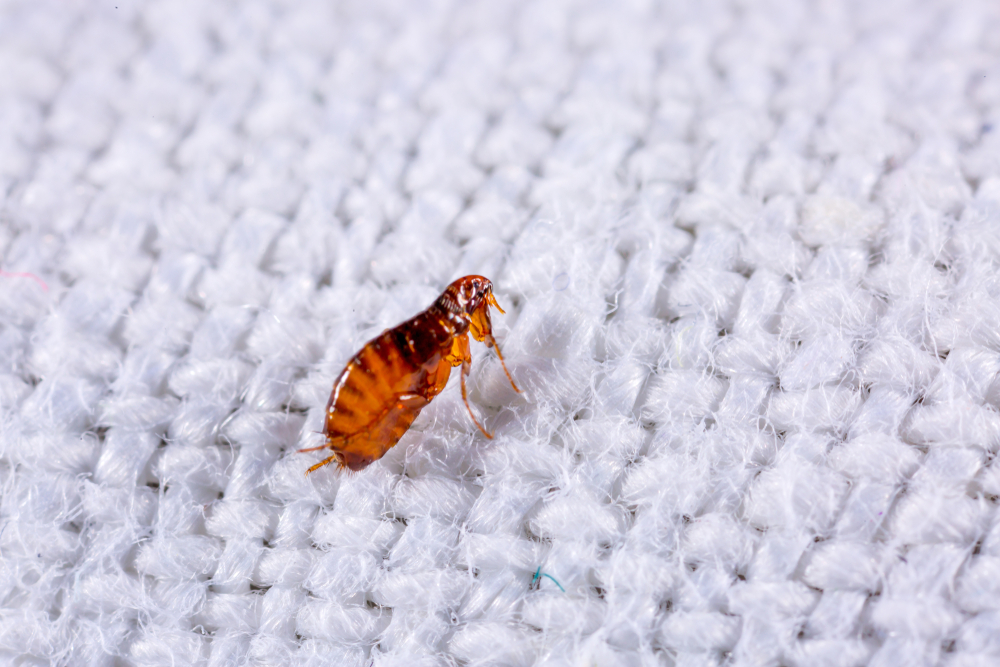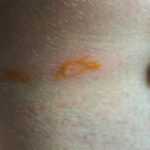What Do Fleas Look Like? Identifying and Treating Flea Infestations
Fleas look like small insects that are reddish-brown in color and measure between 1-4 millimeters in length, frequently jumping across pets. Observing fleas reveals their flat bodies which allow them to glide through animal fur. Fleas, their eggs, and flea dirt are often found in a pet’s fur, so it is important to inspect the pet’s fur closely for signs of flea infestation. Combing through the pet’s fur over a white background can help spot fleas or flea dirt more easily. The small white oval-shaped eggs of fleas contrast with the pale 1/4 inch long larvae which appear as small white oval shapes. Fleas go through four stages of development: egg, larva, pupa, and adult. Adult fleas look reddish-brown and feed on the blood of their hosts, which is essential for their survival and reproduction. This guide explains how to identify each stage of flea development and detect flea infestation indicators.
The adult flea population displays reddish-brown coloration, while eggs and larvae remain difficult to spot during inspection.
Flea infestations become apparent when pets display increased scratching behavior and hair loss, and the presence of flea dirt, which shows up as tiny black specks that verify flea infestation through a simple tissue test.
The best flea treatment plan combines topical and oral medications with regular cleaning and grooming as part of environmental control measures.
Flea Characteristics
Fleas look like tiny wingless insects that deliver severe discomfort to animals. Adult fleas possess a flat body shape, which enables them to glide through animal coats with dimensions measuring between 1 to 4 millimeters. Inspect your pet’s skin and carefully check your pet’s fur for signs of fleas, flea eggs, or flea dirt, as fleas often hide or lay eggs within the fur. Fleas and flea dirt are easier to spot on pets with light colored fur, making early detection of flea infestation more manageable. Their ability to jump up to 7 inches enables dog fleas to easily transfer between different hosts. Fleas look for pets by tracking body heat detection and movement perception, and breathing signals, which direct them to infest animals.
The life cycle stages of fleas, including adults and eggs, and larvae, allow you to identify and properly treat your furry friend.
Adult Fleas
Adult fleas look reddish-brown and display lengths between 1/12 to ⅙ inches and remain fully visible under normal light conditions. These bugs primarily inhabit dogs, which experience discomfort because of the fleas. Fleas look like insects without wings since they depend on their strong legs to move between different hosts. The discovery of these tiny fleas on your pet’s fur marks the beginning of detecting a flea infestation. After feeding on the host, the female flea lays eggs, which is a key step in the flea lifecycle and leads to further flea infestation. Fleas are more than just a nuisance; they can quickly multiply if left untreated, making early identification critical to controlling the flea population.
Flea Eggs
Flea eggs are small, white, oval-shaped objects that blend into their surroundings because they need magnification to be detectable. Female fleas lay eggs following a feeding session, and these eggs naturally detach from your pet to settle in locations where they rest or spend most time.
The detection of these eggs breaks the flea life cycle.
Flea Larvae
The whitish-yellow larvae reach a length of 1/4 inch. These light-sensitive larvae tend to hide in dark spaces such as carpets and furniture as well as pet bedding.
Flea larvae identification helps with early detection and treatment of infestations.
Signs of Flea Infestation
Taking prompt action demands proper identification of flea infestation indicators. Your pet likely has fleas when you notice their excessive scratching behavior combined with hair loss and visible flea dirt. Pets develop chronic scratching behavior because of flea bites. A flea bit can cause an allergic reaction, leading to itching, swelling, and skin irritation. Inspect your pet’s skin for signs of flea bites, redness, or irritation, as these are key indicators of a flea problem. Dry skin results in itching and flakes that form scales or dandruff without the characteristic black specks or bites seen in flea infestations.
Excessive scratching and biting can lead to major hair loss because pets often scratch their bodies repeatedly in specific spots. Serious hair loss and discomfort occur when flea infestations remain untreated.
Daily inspections of pet bedding for flea eggs and larvae will serve as a preventive measure.
Flea Dirt
Flea dirt appears as tiny black specks called flea dirt, which is also known as flea feces or flea poop, that can be observed on the fur of your pet. These “specks” consists of digested blood and is a key indicator of flea infestation. To verify the presence of flea dirt, you should wet a white tissue, then rub it against the specks and check for red discoloration, which proves flea infestation.
The quick test verifies the existence of flea infestation.
Common Flea Hiding Spots
Fleas require treatment of pets alongside their living environment because they hide in multiple spaces throughout your home. Pet bedding and carpets, together with outdoor spaces and floor cracks, represent popular hiding places for fleas. The outdoor areas with tall grass serve as preferred hiding spots for fleas, and their presence also exists inside homes, particularly in carpets and furniture and bedding, and floor cracks.
Fleas thrive in warm, humid environments, and pet bedding is a prime location. Inspect and wash or replace your dog’s bedding regularly, as flea eggs, larvae, and flea dirt are often found in a dog’s sleeping area and contribute to ongoing infestations. If the infestation is severe, discarding and replacing the dog’s bedding may be necessary to fully eliminate flea eggs, larvae, and flea dirt. The accumulation of fleas and their eggs along with larvae and flea dirt on dog’s bedding requires regular cleaning to remove all infestation stages for effective flea control. Make sure to clean your dog’s bedding frequently to eliminate flea eggs, larvae, and dirt, which helps prevent re-infestation. Check for fleas by looking at your pet’s skin or bedding where you will find tiny black specks that resemble flea dirt.
Washing pet bedding with hot water serves as an effective method to control flea populations.
Carpets and Furniture
The fibers of carpets and upholstered furniture provide hiding spots for fleas to establish themselves as infestation hotspots. Regular vacuuming serves as a method to extract flea eggs together with larvae and adult fleas from these areas. Regular vacuuming serves as a critical step to remove fleas together with their eggs and larvae from carpets and furniture while preventing new infestations.
An effective flea control method demands both inspection and cleaning of these spaces.
Outdoor Areas
Fleas prefer to stay in outdoor areas that combine humidity with protection from the sun. The shaded moist areas of tall grass and beneath bushes serve as primary locations for flea concealment. Wild animals such as raccoons, squirrels, and foxes act as flea carriers to your yard, thus increasing the chances of infestation.
Maintaining outdoor areas in a clean state helps to eliminate fleas and decrease flea infestations.
Flea Bites and Symptoms
Flea bites result in serious health problems as well as discomfort, which affects both human beings and their pets. The bite marks of fleas appear as small, red, elevated bumps that usually cluster together. After getting bitten by fleas, people or animals experience both severe itching and swelling at the bite location. Both humans and animals experience flea bites that lead to itchy red bumps.
Some people and animals experience severe allergic responses from being bitten, which produce both itching and rashes. When infections develop after flea bites the affected lymph nodes can become painful. Swollen or painful lymph nodes may also be a sign of infection or an allergic reaction and should be monitored closely. The human body experiences similar symptoms when fleas bite humans as when they bite animals.
Severe scratching can produce additional infections as a result. The appearance of flea bites presents as small red bumps that are raised and grouped together. The skin irritation from a flea bite creates these painful bumps.
Untreated scratching can result in secondary infections.
Secondary Infections and Complications
The skin rash known as flea allergy dermatitis develops when a pet’s skin reacts to flea saliva. The dog’s belly, along with its groin and base of tail, develops symptoms that include intense itching, hair loss, and rash. Night sweats represent an infrequent occurrence that shows a serious allergic reaction in rare instances.
You should contact your veterinarian immediately when these symptoms appear.
The act of scratching flea bites opens wounds that create space for bacterial infections to develop. The continuous action of scratching creates open wounds on pets that make them more vulnerable to developing infections. An infected animal can serve as a host for fleas and contribute to the spread of flea-borne diseases, making it important to identify and treat these animals to prevent further transmission. The symptoms of severe infections or allergic reactions can reach a point where they cause low blood pressure, which demands immediate veterinary care.
The control of flea infestations helps prevent such complications from occurring.
Effective Flea Treatments
The elimination of flea infestations demands multiple steps of treatment. The most effective flea treatments consist of topical solutions and oral drugs together with environmental management strategies to control fleas on both pets and in the environment. The market offers various topical and oral medications which work fast to eliminate fleas; some products kills fleas within 30 minutes to a few hours, providing quick relief. To completely rid your home and pets of fleas, it is important to target all flea life stages through thorough cleaning and treatment. The selection of a fast-acting flea treatment stands essential for successful flea management. Regular vacuuming and washing pet bedding play a vital role in eliminating flea habitats.
Your veterinarian will help you determine the most suitable flea treatment for your pet. Flea bite dermatitis discomfort can be alleviated through natural remedies such as aloe vera gel.
Topical Treatments
Topical flea treatments enable fast skin application to kill fleas immediately. The combination of Advantage II and Frontline Plus offers fast flea death and continuous monthly protection against new flea infestations.
These regular treatments enable flea management and prevent new flea infestations.
Oral Medications
The bloodstream of pets receives medication through oral delivery systems of flea treatments. Oral medications like Capstar are effective because they target fleas after the fleas take a blood meal from the pet, ensuring rapid elimination. The oral medication Capstar provides fast flea elimination and poses no harm to pregnant animals.
The medication successfully targets adult fleas and blocks their reproductive cycle.
Environmental Control
Environmental cleanliness remains essential for managing flea infestations. Hot soapy water washing of pet and family bedding helps eliminate flea eggs and larvae. Regular house cleaning and vacuuming operations remove flea habitats, which helps create an environment without fleas. It is important to vacuum regularly to remove flea eggs, larvae, and adults from the home environment.
Flea management becomes successful when environmental controls remain consistent.
Preventing Flea Infestations
A flea infestation can be avoided through regular pet grooming and ongoing flea prevention, along with maintaining a clean home. Fleas create more problems than annoyance because they transmit diseases that endanger both pets and humans. An infected flea serves as a dangerous pathogen that spreads plague and typhus alongside other parasites, thus making prevention vital. A flea problem remains simpler to prevent than the extensive process of dealing with an established infestation. Regular vacuuming and cleaning practices decrease the number of fleas present in your home.
Flea prevention products used throughout the entire year will keep your pets completely flea-free. To detect fleas, it is vital to check every pet in the household, including all dogs and other cats, for signs of flea infestation. Infect fleas can be detected by observing scratching, skin irritation, and the presence of flea dirt or eggs on your pets.
Regular cleaning methods also protect your pets from parasites like tapeworms and bacteria, which endanger both pets and human health.
Regular Grooming
Maintaining regular grooming supports both your pet’s health needs and their cleanliness. Using a flea comb is an efficient way to remove fleas and their debris from pets. Fleas and their dirt become easier to detect on pets with pale-colored coats, making inspection more successful. Grooming not only allows you to monitor your pet’s skin health but also strengthens the bond you share with your pet.
Year-Round Prevention
The ongoing use of flea prevention products throughout the year protects pets from fleas. Fleas are more than just a nuisance—they can cause serious health issues for both pets and humans, including spreading diseases. Oral medications combined with topical products stop flea eggs from hatching while killing adult fleas. The spread of fleas and related diseases between pets and humans occurs when infected cats are present, so monitoring all pets for infestation signs remains essential.
Frequent and detailed flea inspections on your pet will stop infestations and stop the spread of fleas. Effective flea control requires avoiding all contact with infected animals.
Home Maintenance
The control of fleas requires complete home cleaning with regular vacuuming and washing pet bedding in warm water. Fleas thrive in warm and humid conditions, so they are usually found in carpets, furniture, and pet bedding. The cleanliness of outdoor spaces will decrease flea habitat availability.
Fleas pose a dual threat because they transmit diseases while also creating serious health problems for animals and humans. Fleas exist as parasites that consume blood as their source of sustenance, which enables their survival and population growth. The flea life cycle includes four developmental phases: egg, larva, pupa, and adult flea. Female fleas will deposit eggs after consuming blood from their hosts.
The identification of fleas requires recognizing all three life stages, including adult fleas, eggs, and larvae, as well as observing excessive pet scratching and flea dirt presence. Flea infestations result in weight loss for pets because continuous scratching and blood loss occur. Fleas hide in multiple spots that include pet bedding, carpets, and outdoor areas.
When fleas bite, they cause severe allergic reactions, which can lead to secondary infections if proper treatment is delayed. The parasitic nature of fleas allows them to spread diseases such as cat scratch disease, endemic murine typhus, and other diseases by transferring them through infected fleas.
The treatment of fleas requires topical solutions and oral medications together with strict environmental management. The prevention of flea infestations depends on regular pet grooming combined with yearly protection measures and thorough home maintenance. The control of fleas remains essential because it protects pets and humans from diseases that fleas can transmit. Follow these guidelines to defend your pets against both the discomfort and risks associated with fleas.
Frequently Asked Questions
How can I recognize a flea appearance?
The flea appears as a small reddish-brown or dark brown flat insect which reaches 3 mm in length. The flea has six legs and demonstrates remarkable jumping ability despite lacking wings.
Can people observe fleas with their naked eye?
The human eye can easily detect fleas because these wingless insects appear as tiny brown or black creatures. Their flat bodies together with fast movement create difficulties when attempting to capture them.
My pet displays what symptoms when it becomes infested with fleas?
A flea infestation on your pet reveals itself through continuous scratching as well as shedding fur along with the presence of flea dirt. Flea infestation symptoms in pets include red skin irritation and continuous restlessness.
Fleas prefer to settle in what locations of the house?
The preferred hiding spots for fleas exist in pet bedding and carpets and upholstered furniture found throughout the home. The most effective way to control flea populations requires direct attention to these areas during cleaning operations.
Which methods prove successful in flea treatment?
The most effective flea treatments include topical applications of Advantage II and Frontline Plus as well as oral medication Capstar and thorough environmental care through vacuuming and hot water washing of pet bedding. The combination of these methods provides complete flea control.





